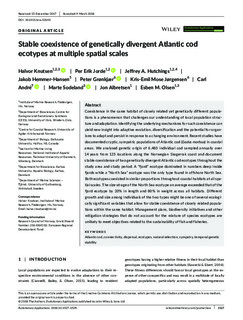| dc.contributor.author | Knutsen, Halvor | |
| dc.contributor.author | Jorde, Per Erik | |
| dc.contributor.author | Hutchings, Jeffrey | |
| dc.contributor.author | Hemmer-Hansen, Jakob | |
| dc.contributor.author | Grønkjær, Peter | |
| dc.contributor.author | Jørgensen, Kris-Emil Mose | |
| dc.contributor.author | André, Carl | |
| dc.contributor.author | Sodeland, Marte | |
| dc.contributor.author | Albretsen, Jon | |
| dc.contributor.author | Olsen, Esben Moland | |
| dc.date.accessioned | 2018-10-25T10:57:59Z | |
| dc.date.available | 2018-10-25T10:57:59Z | |
| dc.date.created | 2018-10-15T08:17:02Z | |
| dc.date.issued | 2018 | |
| dc.identifier.citation | Evolutionary Applications. 2018, 11 (9), 1527-1539. | nb_NO |
| dc.identifier.issn | 1752-4571 | |
| dc.identifier.uri | http://hdl.handle.net/11250/2569548 | |
| dc.description.abstract | Coexistence in the same habitat of closely related yet genetically different populations is a phenomenon that challenges our understanding of local population structure and adaptation. Identifying the underlying mechanisms for such coexistence can yield new insight into adaptive evolution, diversification and the potential for organisms to adapt and persist in response to a changing environment. Recent studies have documented cryptic, sympatric populations of Atlantic cod (Gadus morhua) in coastal areas. We analysed genetic origin of 6,483 individual cod sampled annually over 14 years from 125 locations along the Norwegian Skagerrak coast and document stable coexistence of two genetically divergent Atlantic cod ecotypes throughout the study area and study period. A “fjord” ecotype dominated in numbers deep inside fjords while a “North Sea” ecotype was the only type found in offshore North Sea. Both ecotypes coexisted in similar proportions throughout coastal habitats at all spatial scales. The size‐at‐age of the North Sea ecotype on average exceeded that of the fjord ecotype by 20% in length and 80% in weight across all habitats. Different growth and size among individuals of the two types might be one of several ecologically significant variables that allow for stable coexistence of closely related populations within the same habitat. Management plans, biodiversity initiatives and other mitigation strategies that do not account for the mixture of species ecotypes are unlikely to meet objectives related to the sustainability of fish and fisheries. | nb_NO |
| dc.language.iso | eng | nb_NO |
| dc.title | Stable coexistence of genetically divergent Atlantic cod ecotypes at multiple spatial scales | nb_NO |
| dc.title.alternative | Stable coexistence of genetically divergent Atlantic cod ecotypes at multiple spatial scales | nb_NO |
| dc.type | Journal article | nb_NO |
| dc.type | Peer reviewed | nb_NO |
| dc.description.version | publishedVersion | nb_NO |
| dc.source.pagenumber | 1527-1539 | nb_NO |
| dc.source.volume | 11 | nb_NO |
| dc.source.journal | Evolutionary Applications | nb_NO |
| dc.source.issue | 9 | nb_NO |
| dc.identifier.doi | 10.1111/eva.12640 | |
| dc.identifier.cristin | 1620277 | |
| dc.relation.project | Norges forskningsråd: 216410 | nb_NO |
| cristin.unitcode | 7431,23,0,0 | |
| cristin.unitcode | 7431,20,0,0 | |
| cristin.unitname | Populasjonsgenetikk | |
| cristin.unitname | Oseanografi og klima | |
| cristin.ispublished | true | |
| cristin.fulltext | original | |
| cristin.qualitycode | 1 | |
